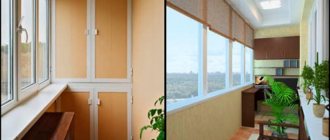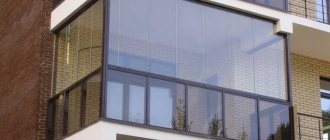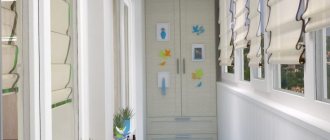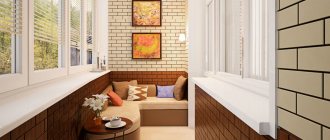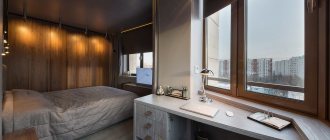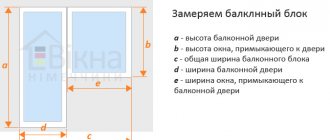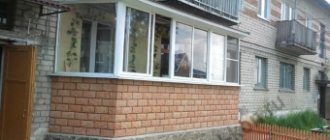Heated discussions on the issue of whether a balcony is part of the common property are due to the difference in apartment owners’ understanding of the concepts of “structural element” and “personal space”. They are trying to attach free access to all residents to the definition of “common property”. Differences in interpretations of current legislative norms were filed in the form of lawsuits in the courts, up to the Supreme Court. Thus, on January 17, 2012, the Appeal Commission of the Supreme Court of the Russian Federation issued ruling No. KAS11-789. Let's look at how shared ownership rights are distributed.
Legal grounds
The Housing Code of the Russian Federation (LC) states that the rules for maintaining common property in apartment buildings are established by the Government of the Russian Federation (Article 39). Such Rules were approved on August 13, 2006 (Resolution No. 491).
Subsection “B”, clause 2 of the Rules classifies balcony slabs that enclose load-bearing structures as part of the property belonging by right of common shared ownership to all owners of individual premises of an apartment building.
The rules and regulations for the technical operation of the housing stock (clause 4.2.4.2) assign balconies to load-bearing structures.
Article 36, Part 1 of the Housing Code establishes the classification of enclosing structures as common property.
Legislative acts do not provide for classifying only those elements that serve several premises as common property. Balcony floors are included in the overall integral design of each building as enclosing structures, providing stability and strength indicators.
What about smoking on your own balcony
In accordance with the Decree of the Government of the Russian Federation dated September 20, 2019, the use of open fire on balconies and loggias is prohibited. We are talking about amendments to fire safety requirements. The document caused a lot of controversy. So is it still possible to smoke on the balcony of your apartment or not?
First, the document does not clearly define what is meant by “open flame source.” Secondly, there is no direct ban on smoking either.
It turns out that you can still smoke on your personal balcony. However, there are fines for non-compliance or violation of the rules. For example, a cigarette butt thrown from a loggia will cost the apartment owner 3,000 rubles.
If it is proven that an unextinguished cigarette butt caused the fire, the owner will have to pay 5,000 rubles. In case of more severe consequences, criminal liability is possible.
Advice: although there is no direct ban on smoking on the balcony, it is better to keep matches and a lighter in the kitchen, and leave cigarette butts in a closed ashtray.
Don't forget about your neighbors. In judicial practice, there are cases where smokers were ordered to pay compensation for moral damage to non-smoking neighbors. To avoid conflicts, install hoods or additionally insulate the room.
Decision of the RF Armed Forces
The determination No. KAS11-789 of the appeal commission states that classifying the structural elements of the balcony of a separate apartment as common property does not in any way contradict the Housing or Civil Code. The Supreme Court of the Russian Federation recognized the balcony (loggia) slab as not intended for use in more than one apartment, but as belonging to the property for the common possession of the residents of the building.
Calculation of the total area of the apartment
But in Chapter 15 of the same document, Part 2, there are instructions for calculating the main area of the apartment - it is made up of the summed up areas of each part of the premises, the area of auxiliary premises that satisfy household and other needs and related to residence is also taken into account (except for balconies, loggias, terraces and verandas).
The SNiP of 2003 also clearly states that the minimum sizes of apartments are calculated by the area of rooms and their number, also without taking into account the area of balconies, loggias, verandas, terraces, apartment vestibules and unheated storage rooms.
Distribution of Responsibility
Common property includes: slab, external fencing, external walls.
Owners of privatized apartments are divided into two camps according to their attitude to the need to repair the balcony:
- Part of your apartment (summer area). When buying a home, this is indicated in some contracts. Accordingly, they arrange their personal territory according to their wishes.
- Component of the facade of a house. Repairs are required to be carried out by the management company (MC) or housing department.
If we summarize all the regulatory documents together, we get the following distribution:
- Common property includes:
- plate;
- external fencing;
- external walls.
- Individual use:
- railings;
- window;
- doors;
- self-installed canopy, glazing, design solutions.
Therefore, responsibility for the maintenance of a specific element of this part of the living space may differ.
Additional approval is required for hanging flower boxes and other protruding objects that weigh down load-bearing parts on the outer part of the fence.
Legislative aspects
A balcony is a platform that stands out from the plane of the facade. It is equipped with a fence and is used to sit on it during the warm season.
When determining the owner of the structure, the concepts of balcony and base slab should be distinguished. The slab refers to the load-bearing structures of a multi-storey, apartment building. This is indicated in the relevant Government Resolution. It belongs to common property. In this case, maintaining proper technical condition and updating the balcony slab should be carried out not by the owner of the apartment, but by the management company.
Balcony slabs have signs of common property according to the norms of the Housing Code (Housing Code). They participate in maintaining the strength and stability of the building and are considered enclosing structures.
How to deal with the distribution of property
In multi-storey buildings, walls, floors, and ceilings separate the apartments; they are not divided between residents - this is shared ownership. To take into account “living space”, the area of residential and utility rooms, measured in m², is used. Such a space is equipped with finishing materials, filled with objects of use, and the ability of anyone to enter is limited. Actual ownership of an apartment, as a set of building materials, is just a legal term.
This is how the right to use a balcony with an exit from a privately owned premises is interpreted - the space indicated in the technical passport of the apartment for the tenant. Improving the situation by installing canopies, light frame structures for protection from bad weather and the sun, their repair, maintenance are included on the balance sheet of the apartment owner, will be part of his property. Some reconstruction options require approval from permitting authorities. The structural elements of the house belong to all participants in the housing association.
It is significant that the same relationships between residents arise when deciding on the placement of advertising structures and banners on the outer surface of the loggias. The general meeting of all owners decides by protocol the issue of consent to the placement of the poster. Moreover, the decision to remove unauthorized advertising products (by a resident, an outsider, a tenant) is also made by all homeowners.
Those parts of the house that are not divided by agreement of all participants according to some other criteria are divided into equal parts by everyone. If one owner has made a permanent improvement to his part, his share may be increased accordingly. The improvements being removed are the property of the resident.
It is for the operation of the building as a complex of technological systems that a mechanism of shared participation of all owners of individual apartments has been developed.
What is a residential premises
So what should be taken as a basis when studying this issue? The Housing Code of the Russian Federation was published on May 1, 2005, because it is the main document on housing issues in our country. All its rules and regulations overlap others from other documents, since they are the ones that have priority. So, in part 2, chapter 16 of this code it is stated that residential premises are:
- residential building, part of a residential building;
- apartment, part of an apartment;
- room.
We are only interested in determining the main living space in an apartment.
Apartment
An apartment is a room in an apartment building that is structurally separate and provides direct access to common areas in such a building. The apartment consists of one or more rooms, as well as additional premises, providing citizens with household and other needs that guarantee a prosperous existence in such a strictly designated room.
Related article: How to level the floor on a balcony
Repair of common household facilities
Maintenance and repair services, their volumes, quality requirements, regularity, are taken into account in the amount of fees for the maintenance of all premises, approved at the general meeting (if the property is managed by the management company), by the management of the HOA.
The commission inspection report is submitted to the HOA meeting for consideration. The meeting is authorized to make a decision on repairs with the consent of 2/3 of the votes of the total number of participants.
To make a competent decision on making repairs due to the emergency condition of the common property (balcony slabs, existing fencing), an application is sent to the director of the management company. One copy must be in the hands of the apartment owner - the applicant, in case of going to court due to refusal. Watch this video to see how the common household repairs are carried out:
The meeting of owners makes a decision on the need to allocate money for repairs at the request of the tenant, taking into account written proposals provided by the management company, on the expected start date of capital work, the required volume and types of work, the estimated cost of building materials, the schedule for the allocation of funds, and other essential conditions.
The owner of the apartment may be required to eliminate changes made to the shared part of the building if they violate established standards. In case of refusal to comply with the requirements, an appeal is sent to the State Housing Commission for inspection of violations.
What rights and responsibilities does the owner of the balcony have?
After we have figured out what is considered common property and what is the property of the home owner, we should find out what rights and responsibilities the owner of the balcony has.
Whose responsibilities include carrying out repairs on the balcony?
Who should carry out repairs and reconstruction depends solely on who owns the item that needs repair. If the item is in common property, the reconstruction must be carried out by the Management Company or the Housing Department. For example, if your balcony slab is cracking and crumbling, then you need to contact the employees of the HOA (homeowners' association), who must make a decision on what repair work needs to be done. Next, an application is written to the director of the Management Commission or the director of the housing department to carry out repairs. The application must be written in two copies, one of which must be kept for yourself in order to go to court if repair work is refused.
Next, the HOA employees will decide how much money needs to be allocated, when to start and finish the work, how much material is needed, and so on.
If the element that is subject to repair and reconstruction is individually owned, then its repair must be carried out by the owner of the dwelling in which it is located.
The dimensions of the slab can only be changed if permission has been obtained. Permission is also required to add a balcony if there was none initially.
It is possible to combine a loggia with a room, but in this case you will have to pay a higher amount for the room that serves as a balcony, since this room will be considered heated.
If changes occur that do not entail a change in the size of the room or the addition of additional structures, and the changes consist of design and decorative changes, then in this case permission is not required.
Accounting changes
A loggia or balcony, as a rule, is included in the total area and is paid with decreasing factors. If the owner carries out a renovation and combines it with an adjacent room, then this area becomes heated with corresponding heat charges.
In practice, management companies often do not include areas such as balconies in the list of property of the house when concluding a contract. Additionally, they confirm the obligation of the apartment owner to maintain their part of the property by sending out and delivering notifications about clearing snow from structures in winter. Taking into account such circumstances, the court takes the side of the company.
A separate point will be the ownership of one room in a separate apartment. In this case, the owner does not have the right to restrict the use of the balcony by all residents of the apartment or to separate it from the common part.
Extension of a balcony on the first floor
Possible, but will require coordination with regulatory authorities, administration and the department of architecture. Along with the package of documents, you must provide a redevelopment project, which is best ordered from a licensed design office. The procedure is long and can take up to 1.5 months.
Construction can begin only after obtaining permits. The compliance of the extension with all standards must be confirmed by a specially created commission, which includes representatives of regulatory authorities. Afterwards, with a signed acceptance certificate, you can contact the BTI to make changes to the apartment’s registration certificate.
You cannot attach a balcony in the following cases:
- if the house is located on the main street, in the historical part of the city, and is an architectural monument;
- if the redevelopment will affect the appearance of the facade or lead to its destruction;
- a balcony cannot be attached if there are utilities next to the house
An extension cannot be used to expand the area, since it is, in fact, the destruction of a load-bearing wall
Read more in the article “Balcony on the first floor“.
What does the law say?
Before understanding and answering the question that interests us, it would be nice to understand the situation from the point of view of the law.
A balcony or loggia is a fenced area protruding from the facade of an apartment building. The Government Decree and the Housing Code state that balcony slabs are common property, since they serve as part of the building, as well as part of the structure, which is considered enclosing. In a word, the walls, the upper part that serves as the ceiling, the balcony slab, and the outer fencing are common house property, because the listed elements serve not only the premises of your balcony or loggia, but also the premises of your neighbors. For example, the balcony slab of the neighbor above serves as your ceiling, and the slab of the neighbor below serves as your floor. And the second reason why the listed elements are considered common property is that they all serve as an integral part of the facade, which is not owned by the residents.
Related article: How to properly insulate a balcony from the inside
Thus, we can summarize and summarize that common property includes:
- balcony slab, because it is a load-bearing delimiting element in an apartment building;
- external walls, since they are considered common property and serve more than one room;
- external fencing.
